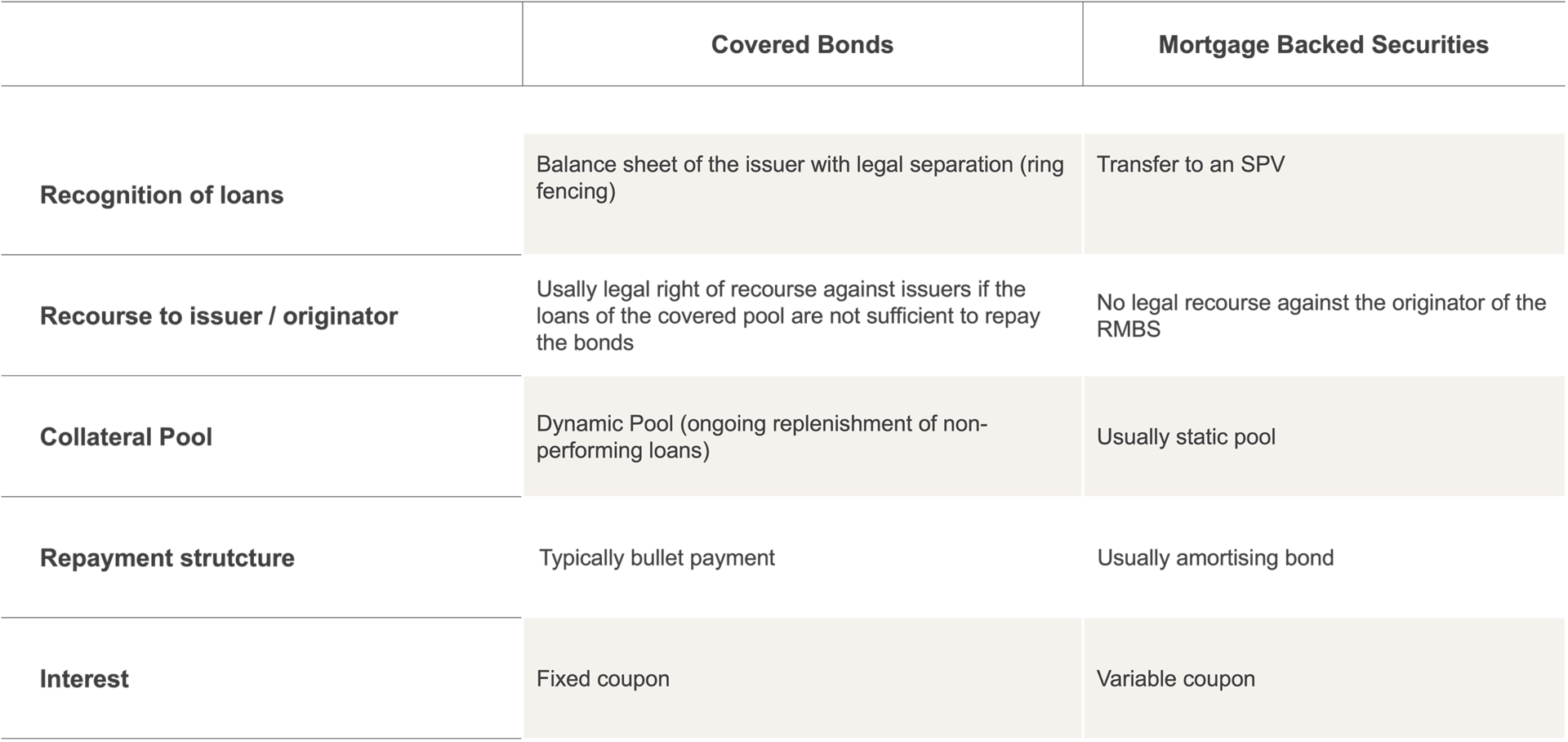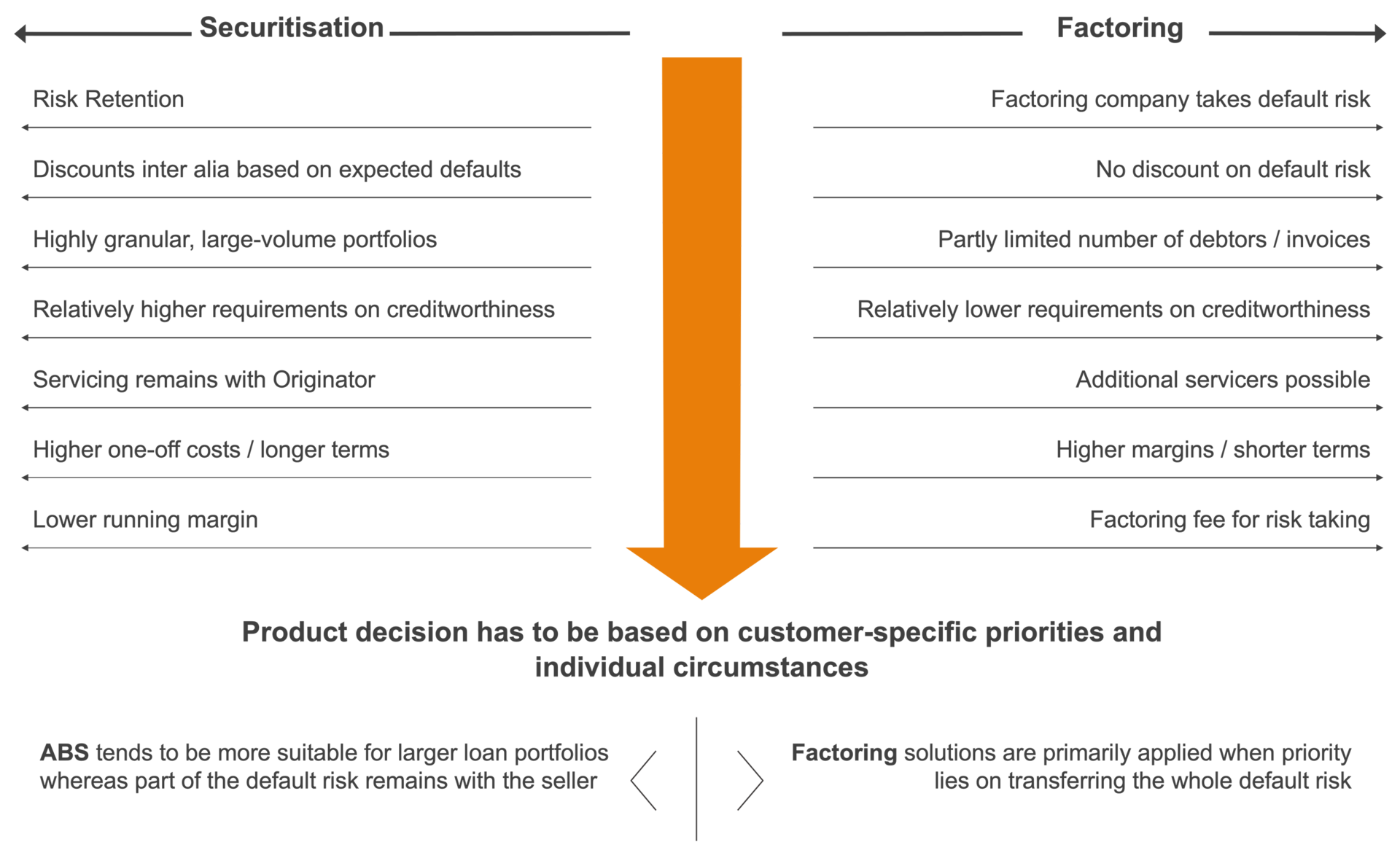Securitisation vs. corporate bonds
Securities issued as part of a securitisation transaction usually have variable interest rates and are referred to as floating-rate notes or floaters. The interest on the notes is based on a variable reference interest rate on the capital market. Only the additional credit spread that the SPV pays to the investor from the cash flows of the underlying receivables is fixed.
Corporate bonds, on the other hand, generally have a fixed interest rate. In contrast to securitisations, the company is liable with all its assets for repayments and interest payment claims. Corporate bonds are therefore fully "originator-backed" and not "asset-backed", in contrast to securitisations. In the event of insolvency, the creditors or investors have no claim on the liquidation proceeds of specific assets. Investor claims are included in the insolvency estate and met in accordance with the insolvency quota.
When purchasing a corporate bond, the investor takes on the specific risk of the company in question. Accordingly, the credit rating of a corporate bond is primarily based on the creditworthiness and expected debt-service capacity of the company. In turn, this depends primarily on the company's performance as well as the development of the industrial sector and the market.
In the case of corporate bonds, issuer reports are primarily governed by external accounting regulations. In securitisations, on the other hand, the originator is obliged to provide further information on the transaction and the portfolio (offering circular, investor reporting). These reports also provide detailed and timely information on the development of the underlying portfolio (delinquencies, defaults, recoveries and prepayments) as well as the development of the notes and the rating. Compared to corporate bonds, the risks associated with securitisations are much more widely spread as there is a pool of receivables.
Securitisation vs. Covered bonds
Pfandbriefe and other forms of covered bonds have a long tradition in Germany. The cover funds formed by banks in this context do not include corporate financing. Instead, long-term property financing, ship and aircraft financing as well as loans to the public sector serve as collateral. In contrast to securitisations, the pool of receivables is not outsourced, but remains on the balance sheet of the issuing bank. The issuing bank therefore remains directly responsible for servicing the investors' interest and redemption claims. In terms of collateralisation, covered bonds are – from the investors' perspective – therefore both "asset-backed" (through recourse to the underlying pool of receivables) and "originator-backed" (through possible recourse to other assets on the issuer's balance sheet). Due to their dual-recourse nature, covered bonds are frequently used by banks and investors.
Stringent requirements are also placed on the quality of the receivables pool for covered bonds, and issuers must meet these requirements at all times. In Germany, the Federal Financial Supervisory Authority (BaFin) and an external trustee, as independent control body, are responsible for monitoring the quality of the receivables pool. In terms of their asset-backed structure, covered bonds are similar to securitisations. In the case of ABCP securitisations in particular, a form of double collateralisation is commonly employed in order to prevent possible liquidity risks. In these securitisations, a bank with a first-class credit rating often provides a liquidity line (sponsor). A special purpose vehicle can draw on this in the event of temporary payment bottlenecks. If the sponsor becomes insolvent, this form of double collateralisation of securitisations might be more beneficial for the investor than covered bonds. This is because the underlyings of securitisations with shorter maturities of less than one year, such as ABCP, generally amortise more quickly than the receivables in a cover pool comprising Pfandbriefe.
Compared to securitisations, covered bonds have the advantage of dual recourse, i.e. the liability of the issuing bank in addition to the collateral pool. On the other hand, securitisations offer the advantage of lower asset encumbrance, i.e. fewer assets needed to secure liabilities, as well as uniform regulation throughout Europe and significantly greater transparency.
Securitisation vs. factoring
In corporate financing, factoring can be an alternative to securitisation in the form of asset-backed commercial paper (ABCP). In factoring, a factoring institution (factor) generally purchases short-term trade receivables from a company as part of a factoring agreement. The receivables are created when the company grants its customers a payment term and thus a supplier credit.
When purchasing the receivables, the factor assumes the full default risk, but obtains a security discount on the purchase price to allow for cash discounts and defects/reclamations. The servicing of the receivables is usually assumed by the factor. In contrast to securitisation with silent assignment, this means that the sale of the receivables is disclosed to the customer.
The factor usually arranges refinancing via bank loans; the securitisation of receivables is another refinancing option. Setting up a securitisation transaction is generally more time-consuming and costly than factoring. However, in the case of financing volumes of between EUR 25 and 50 million, securitisation is financially more attractive than factoring. Especially as volumes increase, securitisations are more cost-efficient than factoring.
The role of securitisation in financing the real economy
The different needs of originators and issuers give rise to differences in the basic structure of the financial instruments and the corresponding forms of refinancing. A mix of financial instruments is conducive to achieving financial market stability in macroeconomic terms. However, financial market regulation and supervisory practice have for many years neglected to maintain a level playing field with respect to the different financial instruments. This has driven capital markets towards certain forms of investment and forced them out of the more strictly regulated financial market. Further development of the securitisation market is necessary, not least with a view to strengthening the financing power of the German economy in the green and digital transformation.



